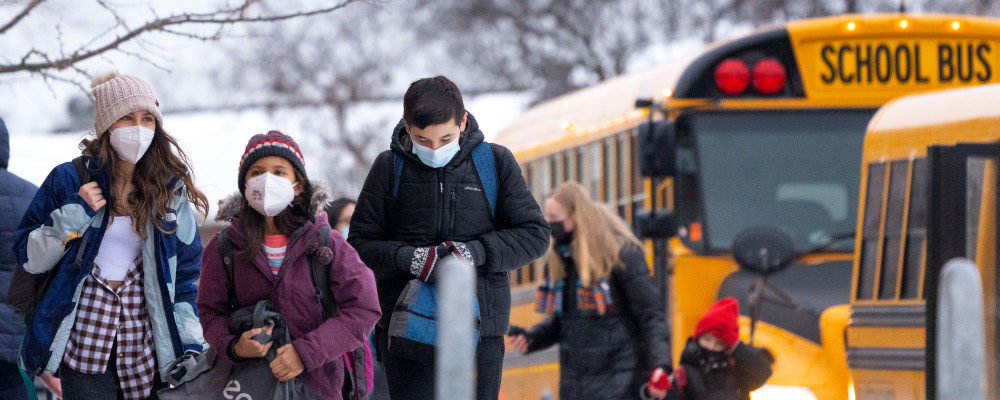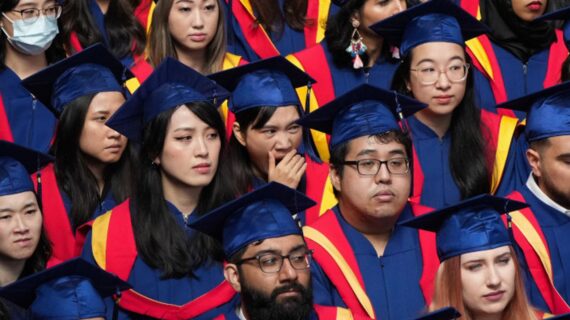Two long years after the pandemic began, it appears that the political consensus on school closures and pandemic restrictions on children is shifting. After all, the data are increasingly in: children infected with COVID are at very low risk of severe illness or death, lower than their risk from the seasonal flu, even before vaccination; schools have not been shown to increase transmission but rather just reflect what is happening in the broader community; and there is still no conclusive evidence that forcing kids to wear masks all day actually helps to reduce COVID spread.
In Canada, journalists are finally, tentatively beginning to ask questions about the forced masking of kids, while in the United States, left-of-centre publications like The Atlantic, The New York Times, and The Washington Post are already pushing for reduced restrictions. On the other hand, we have lots of evidence that the closures and restrictions have harmed kids: academic achievement and physical activity are down, eating disorders, anxiety, and childhood obesity are up. Each day, there is more evidence suggesting that while the initial few weeks of school closures were perhaps justified as a precautionary measure, normal life for kids was quite safe pretty well the whole time and that it’s certainly safe for them now that pediatric vaccines are widely available and the vast majority of adults are vaccinated.
But this essay is not really written to convince those who believe that school closures, mask mandates for young children, and other disruptions to normal school life were all good choices that were always justified and continue to be worthwhile tools. I think the argument there is being won, and that we will look back on the decisions we made about kids during this time with considerable regret. This essay is written for those who are already looking back on those decisions with regret, but who aren’t sure what lessons we should take away from this time. I worry we will—too slowly—return to some form of normalcy in our schools, but the tired modes of thinking and decision-making that caused such harm to kids during the pandemic will remain too influential. So this is the time to think about our education system, to learn why we were so risk-averse when it came to COVID but so reckless when it came to other harms, and then apply that knowledge to improve it.
One problem with the response to COVID in schools has been the outsized influence of teachers’ unions, who have repeatedly failed to prioritize the learning and mental health needs of children over the misplaced anxieties of adults. At every stage, unions advocated longer and more frequent school closures, increased restrictions on children, and decreased responsibilities for teachers. The unions had a moving target approach. They would claim they were in favour of in-person schooling, but not until it was safe, and according to them, it was never safe: not with distancing, not with masking, not with increased ventilation, and not with widely-available rapid tests. No matter what governments did, and no matter what evidence they produced about safety, schools were never safe enough to satisfy the unions, even as the evidence came in that they were among the safest places that kids could be.
As a teacher, this bothered me. I thought our profession was all about helping kids learn and promoting their wellbeing, not protecting ourselves from what are, for the vaccinated, the normal risks of everyday life. Teachers’ unions should have pushed for and modeled a responsible attitude to prioritize kids’ overall wellbeing. They did the opposite, which makes me think they should have considerably less influence in the future of our schools.
Practically speaking, that means policymakers should find more ways to limit the political influence of teachers’ unions, including by limiting their spending in provincial elections and even allowing teachers to opt-out of union membership through a right-to-work system. The Ford government in Ontario, which has faced some of the best-funded and most intractable, if occasionally ridiculous, opposition from teachers’ unions, has shown some backbone when confronting the teachers’ unions already. They should continue if re-elected.
But the outsized influence of the teachers’ unions on school closures and restrictions reveals a broader problem with how most Canadians think about education. We’ve somehow come to believe that politicians, rather than parents, should make all of the important decisions. Of course, in a pandemic, those politicians are guided by public health officials, but they’re also guided, if we’re honest, by polling data, political considerations, and the loudest voices in teacher’s unions and the media. It’s an odd dynamic: Doug Ford or John Horgan or Francois Legault making decisions that immediately affect millions of kids in the most tangible ways, while their parents are allowed to, perhaps, send an email if they disagree. It seems an unbalanced and poorly informed way to make decisions about kids’ educations. After all, the needs of millions of children will vary, and the people who know their needs best—their parents—are not really in control.
Imagine an alternative scenario in which we said parents should be allowed to make the decisions for their own children. We reopened schools to in-person instruction in April or May 2020. Parents looked at the very low death and hospitalization rates of COVID in children and then decided whether they thought the benefits of in-person schooling outweighed those very low risks. When the public health guidance on masking changed from recommending against to recommending in favour to mandating it in many settings, we let parents evaluate the evidence, ask their kids how they felt about it, and make their own decision about whether it was worthwhile. Parents who were worried about their children’s risk from COVID could make more cautious choices, including by telling their own child to wear a mask all day, or even by homeschooling them or enrolling them in one of the many online schools that have been started over the course of the pandemic. Political and public health leaders could have informed and empowered parents to make these decisions based on evidence rather than mandating one-size-fits-all decisions for every child. We could have even allowed different schools to make different decisions about reopening and then allowed parents to choose between them, as was the case in much of the United States.
Now some will say that’s not how a pandemic works. What you do affects me, which means that we need to control each other’s behaviour. But that’s just not really the case for COVID and kids. British Columbia’s early, unmasked reopenings were not associated with increases in school-based or community transmission. Neither were Florida’s reopenings. Neither were Denmark’s. Neither were Finland’s. School-based spread has not been the major driver of the pandemic anywhere in the world. What we do matters to others, but when it comes to kids, schools, and COVID, we know now that letting parents decide would have worked better than the one-size-fits-all approach that we took.
The lesson from this is that we need to reform all provincial education systems to recognize all parents’ rights to make decisions about their kids’ educations. One good first step for policy-makers would be to preemptively allow parents to opt their children out of the mask mandates that some schools may impose once provincial mandates are removed. In Virginia, the newly-elected governor did this as an interim step towards getting rid of mask mandates entirely, and its political genius is precisely that it rightly frames this issue as a matter of parental choice rather than government control.
But that’s not enough. If politicians can’t make good one-size-fits-all decisions on COVID, a hyper-specialized issue that demands significant expertise, why should we think they can make all the right decisions for every family about more subjective topics like school admissions, curricula, testing, and behaviour policies?
In the medium to long term, policymakers should work to expand school choice to allow more parents to send their kids to schools that better reflect their perspectives on these more subjective issues. This could include establishing educational savings accounts, or “funding backpacks,” that take part of taxpayer dollars that would have gone to a child’s local government-run public school and allow their parents to spend it on the education they actually choose, whether those are independent schools, homeschooling programs, or even specialized public schools outside their assigned zone. A more decentralized system would provide more choices to parents, who know their kids’ needs best and should be making more of the decisions for them. It would also help create competition between schools, which has been shown to boost educational outcomes for all kids, including those in traditional, government-run schools. No longer could a single school fail families for generations. If parents were dissatisfied, they could seek other options elsewhere, which would have been helpful during this pandemic, and will continue to be helpful after it.
Canada’s children have borne some of the greatest costs of the decisions we have taken during this pandemic. Coming out of it, the least that we can do is try to learn some lessons. For our education system, at least one lesson is clear: Parents deserve more influence, while politicians and teachers’ unions deserve less. If policymakers can learn and apply that lesson, then perhaps we can emerge from this pandemic better prepared to help kids recover from it.




